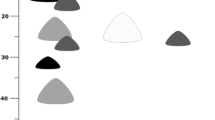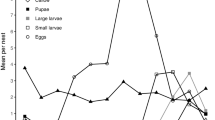Abstract
In the fell-field habitat at 140–270 m altitude on the sub-Antarctic Ile de la Possession, Iles Crozet, the dimorphic beetle Amblystogenium pacificum Putzeys (Coleoptera: Carabidae) was studied monthly throughout the southern year 1993–1994 by timed hand collections involving turning stones on the rocky fell-field. There were many mating couples and females containing well-developed eggs in every month and the species reproduced throughout the year, with no evidence of a winter cessation of egg production. However, the frequency of mating couples was about twice as great in the summer half-year (October–March) as in the winter half (April–September). Relatively small differences in monthly mean temperatures between the summer and winter at Iles Crozet render all-year reproduction not unexpected when comparisons are made with the temperatures and phenology of Carabidae in cool habitats in other parts of the world. Mating pairs were collected at unusually high frequencies for carabids. The frequency of such pairs, taken per unit effort by hand collecting, was highest in October–December, lower from January to May and intermediate from June to September. Comparison of beetles taken as solitary, non-mating individuals with those taken as mating couples showed that in summer, females of the black morph of this dimorphic species were more frequently involved in mating than expected, but no differences were detected in winter. Female beetles were divided into younger individuals (putative age 1–2 years) and older females (putative age 3–5 years or more) by the amount of claw-wear on individuals of this species. This division indicated that about 40% of the older females showed no egg development when captured, but only about 20% of the younger females were non-breeding. However, of the reproducing beetles, young and old females matured similar numbers of eggs. An altitude transect showed that the proportion of the black morph increased significantly with altitude. Studies at 140–270 m showed that a significantly smaller proportion of the older females of the brown morph were breeding than in the younger brown individuals, and this effect was particularly evident in the colder winter period. No such age differences existed amongst the black morph.

Similar content being viewed by others
References
Butterfield JEL (1986) Changes in life cycles strategies of Carabus problematicus over a range of altitudes in Northern England. Ecol Entomol 11:17–26
Davies L (1972) Two Amblystogenium species (Col. Carabidae) co-existing on the sub-Antarctic Possession Island, Crozet Islands. Entomol Scand 3:275–286
Davies L (1973) Observations on the distribution of surface-living land arthropods on the sub-Antarctic Ile de la Possession, Iles Crozet. J Nat Hist 7:241–253
Davies L (1982) Ecology of two Amblystogenium species (Carabidae) on Ile de la Possession, Iles Crozet. Comp Nat Fr Rech Antarct 51:167–173
Davies L (1987) Long adult life, low reproduction and competition in two sub-Antarctic carabid beetles. Ecol Entomol 12:149–162
Dreux P (1965) Faune entomologique de l’Ile de la Possession (Archipel Crozet). Terres Aust Antarct Fr 30:58–73
Ernsting G (1993) Observations on life cycle and feeding ecology of two recently introduced predatory beetle species at South Georgia, sub-Antarctic. Polar Biol 13:423–428
Ernsting G, Isaaks JA (1988) Reproduction, metabolic rate and survival in a carabid beetle. Neth J Zool 38:46–60
Ernsting G, Block W, MacAlister H, Todd C (1995) The invasion of the carnivorous carabid beetle Trechisibus antarcticus on South Georgia (sub-Antarctic) and its effect on the endemic herbivorous beetle Hydromedion sparsutum. Oecologia 103:34–42
Greenslade PJM (1968) Habitat and altitude distribution of Carabidae (Coleoptera) in Argyll, Scotland. Trans R eEnt Soc Lond 120:39–54
Gross J, Schmolz E, Hilker M (2004) Thermal adaptations of the leaf beetle Chrysomela lapponica (Coleoptera: Chrysomelidae) to different climes of Central and Northern Europe. Environ Entomol 33:799–806
de Jong PW, Brakefield OM (1998) Climate and change in clines for melanism in the two-spot ladybird, Adalia bipunctata (Coleoptera: Coccinellidae). Proc R Soc Lond B 265:39–43
Mani MS (1962) Introduction to high altitude entomology. Methuen & Co., London, p 304
Mani MS (1968) Ecology and biogeography of high altitude insects. Dr W Junk NV Publishers, The Hague, p 527
Paarmann W (1979) Ideas about the evolution of the various annual reproduction rhythms in carabid beetles of the different climatic zones. In: On the evolution of behaviour in carabid beetles, vol 18. Landbouwhogeschool, Wageningen, pp 119–132 (Miscellaneous papers)
Refseth D (1988) Annual patterns of activity, reproduction and development in some Norwegian Carabidae (Col). Fauna Norvegica Ser B 35:21–30
Roland J (1982) Melanism and diel activity of alpine Colias (Lepidoptera: Pieridae). Oecologia 53:214–221
Roland J (2006) Effect of melanism of alpine Colias nastes butterflies (Lepidoptera: Pieridae) on activity and predation. Can Entomol 138:52–58
Sota T (1994) Variation in carabid life cycles along climatic gradients: an adaptive perspective for life-history evolution under adverse conditions. In: Danks HV (ed) Insect life-cycle polymorphism. Kluwer, Dordrecht, pp 91–112
Strathdee AT, Bale JS (1998) Life on the edge: insect ecology in arctic environments. Annu Rev Entomol 43:85–106
van Dijk TS (1979) On the relation between reproduction, age and survival in two carabid beetles: Calathus melanocephalus L. and Pterostichus coerulescens L. (Coleoptera, Carabidae). Oecologia 40:63–80
Vernon P, Caron F, Davies L (1999) Annual activity of two endemic beetles (Carabidae) at the edge between fell-field and moorland on a sub-Antarctic island. Eur J Soil Biol 35:39–43
Wilson K, Cotter SC, Reeson AF, Pell JK (2001) Melanism and disease resistance in insects. Ecol Lett 4:637–649
Acknowledgments
This work is supported by the Institut Polaire Français Paul Emile Victor (Programme 136). We are grateful to Yves Picard for assistance. John Coulson commented on the paper in draft and suggested several improvements.
Author information
Authors and Affiliations
Corresponding author
Rights and permissions
About this article
Cite this article
Davies, L., Bouvet, S. & Vernon, P. All-year reproduction and possible thermal melanism in Amblystogenium pacificum (Coleoptera: Carabidae) on the sub-Antarctic Ile de la Possession (Iles Crozet). Polar Biol 30, 253–260 (2007). https://doi.org/10.1007/s00300-006-0240-4
Received:
Revised:
Accepted:
Published:
Issue Date:
DOI: https://doi.org/10.1007/s00300-006-0240-4




